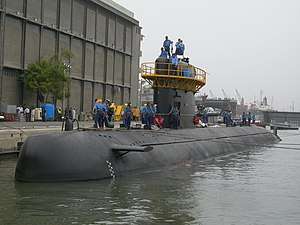PNS Hamza
PNS/M Hamza (S-139) is a fast-attack submarine powered with an air-independent propulsion system and the third submarine of her Agosta 90B/Khalid-class submarine. She was designed and constructed by the KESW Ltd. under the technology transfer agreement with France in 1994.
 PNS Hamza being prepared for her depth testings in Karachi in 2006. | |
| History | |
|---|---|
| Name: | PNS Hamza |
| Namesake: | Ḥamzah |
| Ordered: | 21 September 1994 |
| Builder: | KESW Ltd. in Pakistan |
| Laid down: | 1 March 1997 |
| Launched: | 10 August 2006 |
| Sponsored by: | Sehba Musharraf |
| Commissioned: | 23 September 2008 |
| In service: | 2008–present |
| Homeport: | Jinnah Naval Base |
| Identification: | S-139 |
| Status: | In service |
| General characteristics | |
| Class and type: | Agosta 90Bravo/Khalid-class submarine |
| Displacement: |
|
| Length: | 249.4 ft (76.0 m) |
| Beam: | 22.3 ft (6.8 m) |
| Draught: |
|
| Installed power: | 2 × Jeumont-Schneider alternators producing: 4,600 hp (3,400 kW). |
| Propulsion: | 2 × SEMT Pielstick 16 PA4 V 185 VG AIP MESMA: 3,600 hp (2,700 kW), 1 × shaft. |
| Speed: |
|
| Range: | 10,000 miles (16,000 km) at 9 knots (17 km/h; 10 mph)[3] |
| Endurance: | 150 Days |
| Test depth: | 1,968.5 ft (600 m)[4] |
| Complement: | 50 (10 officers, 40 enlisted)[5] |
| Sensors and processing systems: | Towed array sonar |
| Electronic warfare & decoys: |
|
| Armament: |
|
PNS Hamza is the first submarine that has been fitted with the French MESMA system, which was an experimental at that stage– Pakistan is the first country to use the MESMA system in a deep sea on board on a submarine. The system was later fitted with the Scorpène-class submarine, used by the Indian Navy. It was the first submarine built in South Asia to feature Air-independent propulsion.[6]
Design overview
PNS Hamza was ingeniously designed and built by the KESW Ltd. at the Karachi Naval Dockyard, with the participation of more than 300 civilian engineers and technicians trained in France's defense industry.[5] In 1999–2004, the French and other European contractors reportedly trained more than 600 Pakistani machinists and metal workers in various construction skills of the submarine to meet the challenges of modern warfare in which submarines play a vital role.[5] The construction of the submarine reportedly involves the employment of the local metal industry in the Navy's submarine construction program as had done previously when Saad was being rebuilt.[5]
PNS Hamza is the most advanced version of the Agosta 90B design and is more advanced than her two sister ship, Khalid and Saad, as its outer hull is light steel structure, HLES 80, was built at the Pakistan Steel and fabricated at the Naval Dockyard in Karachi in element parts and mounted on the inner pressure hull.[7] The pressure hull section was fabricated and outfitted by the Naval Dockyard in collaboration with the Karachi Shipyard.[7]
PNS Hamza was laid down on 1 March 1997 in Karachi, and the steel cutting started by the Pakistan Steel Mills.:530 The construction of the submarine started in 1998 by KESW Ltd. at the Karachi Naval Dockyard, followed by fabrication of 12 pressure hull sub-sections and culminating into three pressure hull sections. This was followed by mounting of light bulkheads, internal tanks and ballast panels in August 2003.[5]
On 10 August 2006, Hamza was launched, sponsored by Sehba Musharraf, the First Lady of Pakistan, and is namesake after Ḥamzah ibn ‘Abdul-Muṭṭalib– the companion and paternal uncle of Muhammad. Her maximum depth test was approximated at the 1,968.5 ft (600 m) in the Indian Ocean[4] with the MESMA system, and is capable of launching the Exocet SM39 missiles while submerged on a seaborne platform.[9]
After completing series of depth tests and sea trials in the Indian Ocean, Hamza was commissioned by then-Prime Minister Shaukat Aziz on 23 September 2008, and joined the Navy's Submarine Command on 26 September 2008.[9][10] Her crew complement is reported as 50 personnel (10 officers, 40 enlisted).[5]
See also
- List of ships of Pakistan Navy
References
- "Accountability should be across- the-board: Asma". The News. 11 July 2006. Archived from the original on 30 December 2018. Retrieved 30 December 2018.
- Jane, Frederick Thomas (1999). Jane's Fighting Ships. S. Low, Marston & Company. p. 637. ISBN 9780710619051.
- "Agosta submarine will enhance PN capability". Dawn. 11 July 2006. Archived from the original on 30 December 2018. Retrieved 30 December 2018.
- "Pakistan Submarine Capabilities". NTI. Archived from the original on 12 January 2020.
- "Another Agosta submarine ready". Dawn. 23 September 2008. Archived from the original on 30 December 2018. Retrieved 30 December 2018.
- "Pak submarine joins naval drills in Jubail". Arab News. 13 May 2014. Archived from the original on 25 September 2017. Retrieved 30 December 2018.
- "Submarine Hamza to be commissioned on Sept 26". Aaj News. Associated Press of Pakistan. Archived from the original on 30 December 2018. Retrieved 30 December 2018.